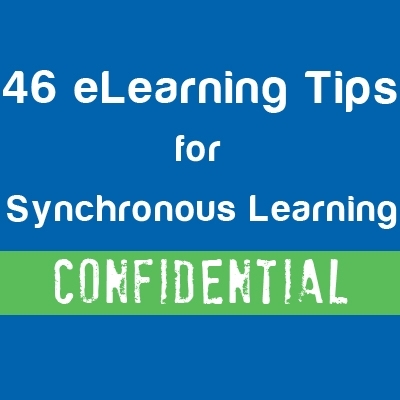The following 49 eLearning Tips for synchronous learning were contributed by the following eLearning bloggers:
-
- 25 Tips For Successful Online Course Facilitation by Matthew Guyan,
- 16 Essential Tips for Planning a Virtual Classroom Event by Montoute Rosanna, and
- Top 5 Tips To Avoid Sucky Virtual Classrooms by Brian Bishop.
Enjoy, and let us your thoughts!
25 Tips For Successful Online Course Facilitation
Before The Online Course Starts
- Familiarize yourself with the course delivery structure and the site/platform
- Develop an online delivery plan/schedule
- Check that all resources, activities and links work (i.e. they open in a new window), are current and relevant to the learning experience
- Update your contact information
- Contact learners, welcome them to the course and provide clear log-in instructions
At The Beginning Of The Online Course
- Check that learners can log-in and provide support and troubleshoot as needed
- Facilitate introductions and community-building activities at beginning of the course e.g. have everyone introduce themselves in a café style forum
- Set clear expectations
- Confirm contact/turnaround times
- Emphasize the importance of interactions and that online communication between participants is key to building community and contributes to the course outcomes, profiles, forums, chats etc.
- Encourage sharing of experiences
During The Online Course
- Be a positive online role model
- Send some sort of meaningful weekly communication, but, don’t overwhelm learners
- Ideally respond to learner’s communication within a reasonable time frame to resolve any difficulties/queries to ensure their learning is not interrupted e.g. phone calls, email, messaging, and forum posts
- Provide guidance and direction to learners when needed
- Encourage online communication between participants
- Relate to learner experiences and ask thought provoking questions
- Promote learner independence/responsibility and learner collaboration
- Provide technical and other learner support as required
- Online learning can be isolated and lonely so provide positive encouragement and feedback
- Monitor learner progress, participation in activities and completion of assessment tasks and follow up as required
- Provide informative developmental feedback
After The Online Course Finishes
- Wrap-up the course, thank learners for their participation
- Review learner feedback and make recommendations for improvement
- Engage in your own self-reflection for improvement and consolidation
16 Essential Tips for Planning a Virtual Classroom Event
- Assess your skills at moderating Virtual Classrooms events
- Assess your knowledge of the virtual event’s topic or subject
- Determine the objective of the virtual event
- Assess your skills and experiences with features and functions of the Virtual Classroom software
- Invite a Guest Speaker such as a Subject Matter Expert (SME)
- Assess the Guest Speaker or SME’s familiarity with the features and functions of the Virtual Classroom Software
- Determine the system requirements such as versions of: Windows, Mac, Linux etc. needed to participate in the event
- Prepare a tentative agenda (subject to modification) when more is known about the participants
- Send out an invitation to potential participants (invitations can be prepared directly from the Virtual Classroom Software)
- Promote the event via email and Social Networks
- Assess the participants’ knowledge of the event’s subject or topic
- Assess the participants’ familiarity with the features and functions of the Virtual Classroom Software
- Arrange a Virtual Classroom orientation prior to the event for the participants who are not familiar with the software
- Go through the event requirements checklist
- Revise the event’s agenda according to the particularities of the registered participants
- Send out at least three scheduled reminders to registered participants
5 Tips To Avoid Sucky Virtual Classrooms
- Cut the fluff. We went through the original f2f facilitator guide and identified all “icebreakers,” games, and other non-essential training activities. Instead of using training time for these, we posted them as messages on a social network like Google Groups. Learners controlled the discussions. By doing so, we reduced the time required for instructional designers to create interactions, as well as the trainer’s time to deliver them, and the learners’ time to suffer through them.
- Turn lectures into YouTube videos. Instead of listening to the trainer drone on in the virtual classroom over PowerPoint slides, learners watched shortened lectures on their schedule and used Rewind if they needed to. While we didn’t reduce instructional design time because we had to create the videos, we reduced classroom time. (We could have created self-paced elearning to cover the lecture materials, but in most cases this was overkill.)
- Create a non-graded workbook of activities. After learners finished watching each lecture video, they tackled workbook activities related to the material. They did it on their own and they often found they had to go beyond the video lecture, Googling to go in depth, or returning to the social network to ask questions of their colleagues. Trainers didn’t need to grade the workbooks – they could tell who was doing the work when the learners came into the virtual classroom.
- Use the virtual classroom to practice skills. After learners watched the lecture videos and attempted the workbook activities, they came into the classroom to ask specific questions, role-play, and practice job-specific skills such as searching the electronic performance support system. The trainer merely introduced the activities. Learners guided each other through, creating an atmosphere of camaraderie and collaboration.
- Build a targeted performance support system. The L&D team used its saved time to create a user-friendly, smart knowledge-base for agents to find answers quickly when they were on the job. As a result, the training program didn’t require learners to memorize tomes of information. It was like Google, only specific to the job.
Originally published on September 18, 2013








